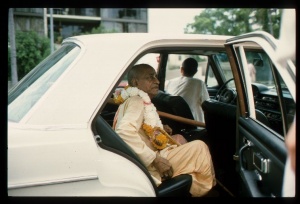CC Madhya 16.130 (1975)

A.C. Bhaktivedanta Swami Prabhupada
Below is the 1996 edition text, ready to be substituted with the 1975 one using the compile form.
TEXT 130
- gadādhara-paṇḍita yabe saṅgete calilā
- ‘kṣetra-sannyāsa nā chāḍiha’—prabhu niṣedhilā
SYNONYMS
gadādhara-paṇḍita—Gadādhara Paṇḍita; yabe—when; saṅgete—with Śrī Caitanya Mahāprabhu; calilā—started to go; kṣetra-sannyāsa—the renounced order of life at a holy place of pilgrimage; nā chāḍiha—do not give up; prabhu niṣedhilā—Lord Śrī Caitanya Mahāprabhu forbade.
TRANSLATION
When Gadādhara Paṇḍita started to go with the Lord, he was forbidden to come and was asked not to give up the vow of kṣetra-sannyāsa.
PURPORT
When one takes kṣetra-sannyāsa, he leaves his household life and goes to a place of pilgrimage devoted to Lord Viṣṇu. Such places include Puruṣottama (Jagannātha Purī), Navadvīpa-dhāma and Mathurā-dhāma. The kṣetra-sannyāsī lives in these places alone or with his family. Śrīla Bhaktivinoda Ṭhākura considers kṣetra-sannyāsa to be the preferable vānaprastha situation in this Age of Kali. Sārvabhauma Bhaṭṭācārya lived in this way, and he has been called a kṣetra-sannyāsī—that is, a sannyāsī living in Jagannātha Purī.